Nissan is now offering an all-wheel-drive version of the Ariya electric SUV. e-4ORCE models promise greater traction and much more performance than the standard Ariya, all without sacrificing amenities or totally savaging the range. Sounds like a winning combination. And you know what? It is.
The basics
The Ariya is Nissan’s first all-electric SUV, a vehicle that follows in the tire tracks of the Japanese automaker’s pioneering Leaf hatchback. A mainstream offering, this utility vehicle competes with rival models like the Mustang Mach-E, ID.4 and Hyundai Ioniq 5, though in range-topping Platinum+ trim, the Ariya feels more upscale than either the Ford or Volkswagen.
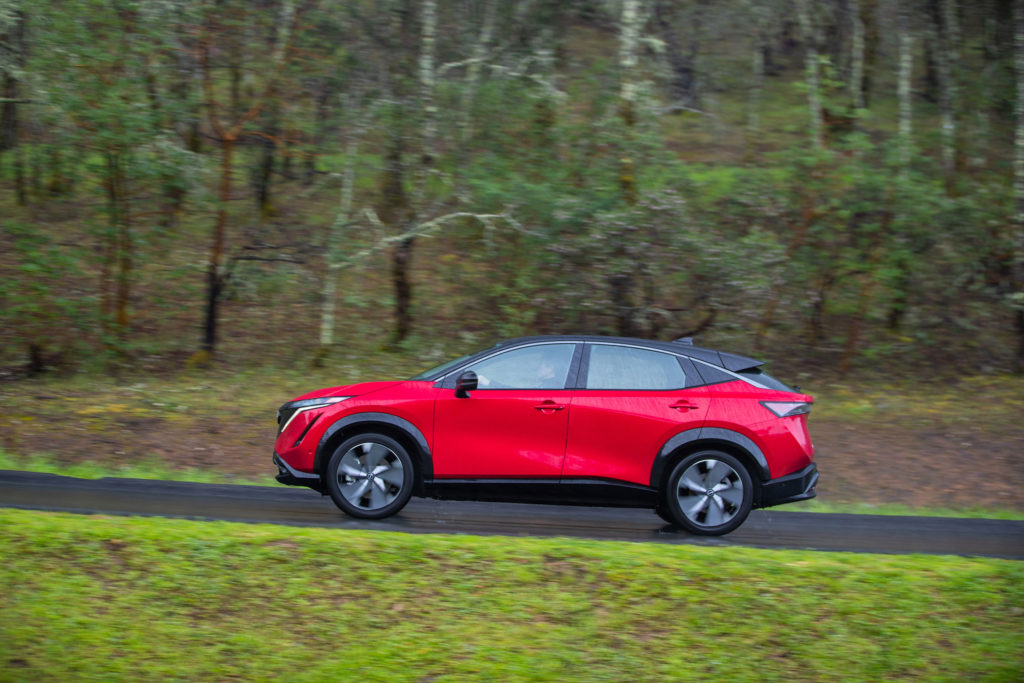
Visually, not much sets e-4ORCE models apart from front-drive Ariyas. The badging is slightly different, 20-inch wheels are available and inside, Nappa leather comes standard in the top-shelf model. Aside from that, every Ariya feature a somewhat pug-like front end and a bulbous body. Sure, this SUV looks nice enough in person, but you’ll have to decide whether you like the styling or if you’d rather have something more angular like the Ioniq 5.
Technical tidbits
Just like front-drive Ariyas, e-4ORCE models are offered with two battery sizes, a smaller pack that has 63-kilowatt-hours of usable capacity and a larger one that clocks in at 87. Range varies between about 205 miles on the low end to a max of around 270. For reference, the longest-range front-drive Ariya tops out at 304 miles on a charge, so there’s not too much of a drop here, even if you nab a Platinum+ e-4ORCE Ariya, which Nissan estimates can go 265 miles between charges.
SEE ALSO: 2022 BMW iX xDrive50 review: The future is now
When it’s time to juice up, the Ariya is, unfortunately, not very impressive because this SUV tops out at a lackluster 130 kilowatts. In comparison, Hyundai’s E-GMP-based cars including the Ioniq 5, Kia EV6 and Genesis GV60 charge about 100 kW faster than this Nissan. But hey, at least the Ariya uses a conventional CCS plug, not a CHAdeMO port like the Leaf.
Of course, maximum advertised speeds are not the end all and be all of DC fast charging. What’s far more important is how long an EV can maintain a high level of charge, because that’s what really determines how long you have to sit in the grocery store parking lot. As for the all-important 10-to-80% charging time, Nissan estimates an Ariya e-4ORCE with the small battery will require around 35 minutes to achieve this feat; examples fitted with the big battery will need about 5 additional minutes to hit an 80% state of charge. Overall, this is about twice as long as an E-GMP-based car takes to do the same thing, but the performance is in line with a Mach-E and ID.4. Of course, we’ll put the Ariya through our EV Pulse Charging Challenge once examples become available locally for testing, so stay tuned for that.
A lovely interior, at least in the top trim
Reflecting inward, there’s plenty to like about the Ariya’s cabin and even a few amenities to love. At least in Platinum+ trim, the materials on display are lovely. There are plenty of soft plastics, the dashboard and door panels are trimmed with a rich-feeling suede trim and buttery Nappa leather comes standard. Providing four-season livability, the front bucket seats are also heated and ventilated, plus they’re plenty comfortable.
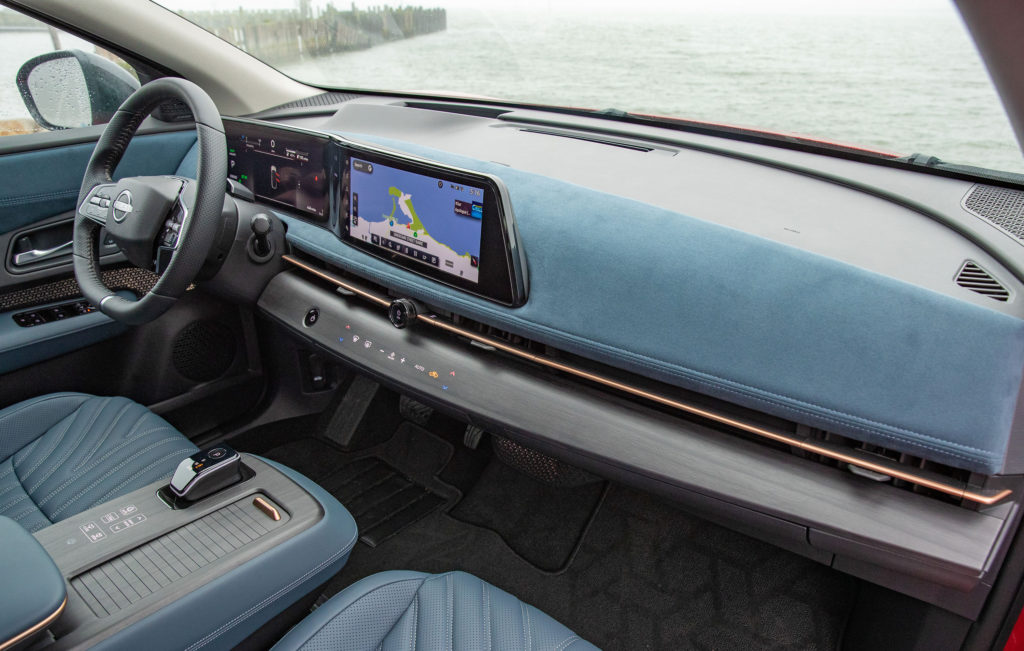
Adding some visual interest to the Ariya’s otherwise cleanly styled cabin is a Japanese kumiko geometric pattern. This is employed on the speaker grates, footwell, floor mats, door panels and even front and center on the vehicle’s exterior grille.
The dashboard is topped by a pair of 12.3-inch displays mounted in a single curved housing. One of these panels is for the digital instrument cluster and the other is touch-enabled for multimedia duties. Nissan’s infotainment system seems intuitive and responsive enough, but I didn’t get enough time to really test it out during the first-drive event, so I reserve judgment until I have a chance to really dig through it. This system does support Amazon Alexa and wireless Apple CarPlay, but bring a cable if Android Auto is you jam.
That’s all pretty standard stuff these days. But the Ariya also has a few outstanding features, including some clever controls. The dashboard and center console feature touch buttons that are mounted underneath the trim. This sounds like a usability disaster in the making, but thanks to strong haptic feedback and finger-friendly textures those controls work surprisingly well. Additionally, there’s a hidden storage drawer that powers out from the center of the dashboard. This is a great place to stash valuables, so they’re hidden from prying eyes. And lastly, the center console can motor forward and back at the push of a button, a feature that’s not super useful, but it should help drivers of different heights get comfortable behind the wheel while allowing them to easily reach various controls.
CHECK THIS OUT: 2023 Genesis Electrified G80 review: Smooth operator
Passengers and cargo will appreciate the Ariya, too. Luggage space is respectable, with nearly 23 cubic feet with the second-row backrests up and almost 60 with them lowered. Unfortunately, there is no front trunk. This vehicle’s floors are also nearly flat, so there’s no annoying hump for rear seat passengers to contend with.
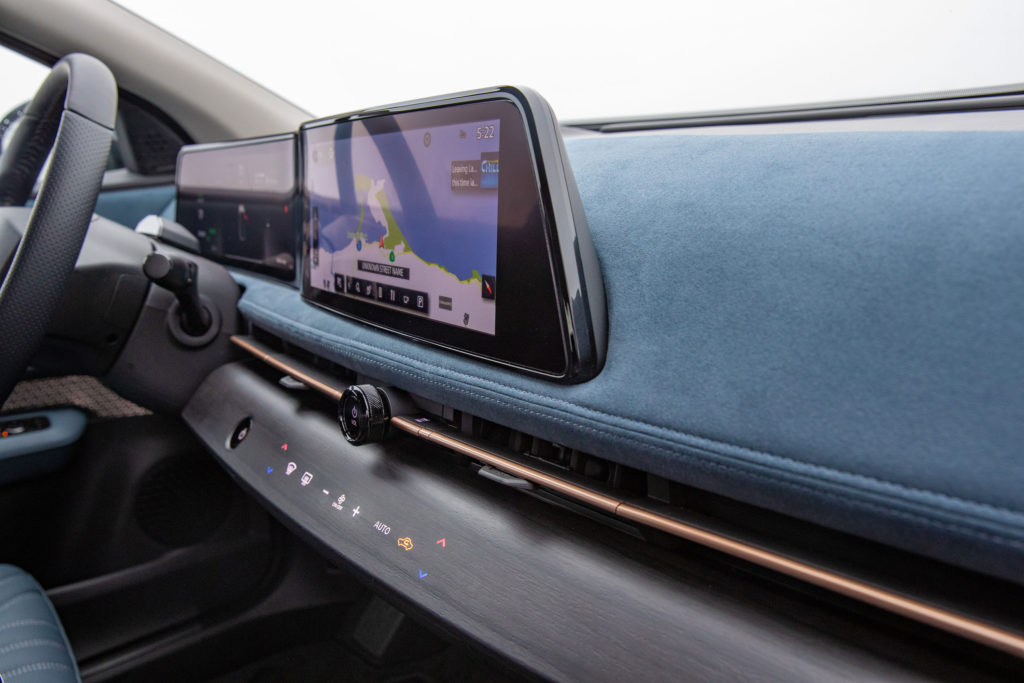
Of course, there are a couple things I don’t care for inside the Ariya, and one is the shifter. This SUV’s gear selector looks like a blackened little brick of Parmesan cheese, one that slides fore and aft, much like what you get in the Rogue crossover. This setup works fine, though it feels a little loose and fiddly. I’d much prefer a rotary knob or just some push buttons. And two, I noticed the center armrest and the armrest on the driver’s door don’t seem to be the same height, which causes you to sit a bit lopsided, something that could get uncomfortable on long drives.
Potent performance, stable handling
With the smaller battery, front-drive Ariyas crank out 214 horsepower. Opting for the larger pack gets you 238 ponies, though either way you get the same 221 pound-feet of torque. These figures are more than adequate for nearly any situation, but if you want more zest, e-4ORCE is the obvious way to go.
With two electric motors onboard, all-wheel-drive Ariyas are, not surprisingly, far more potent. The Platinum+ version delivers 389 horses and 442 lb-ft, enough to propel this SUV to 60 mph in a legitimately quick 4.8 seconds. e-4ORCE models with smaller battery pack are slightly less potent, graced with 335 hp and 413 lb-ft.
That all-wheel-drive system helps distribute torque between each wheel for stable handling in all situations. Demonstrating this, Nissan setup a short handling course that included a section of wet asphalt. The Ariya manages tight corners easily at speed, stubbornly refusing to oversteer, even when you dive into a turn with reckless abandon and the accelerator pegged. The vehicle remained neutral and planted despite my best efforts.
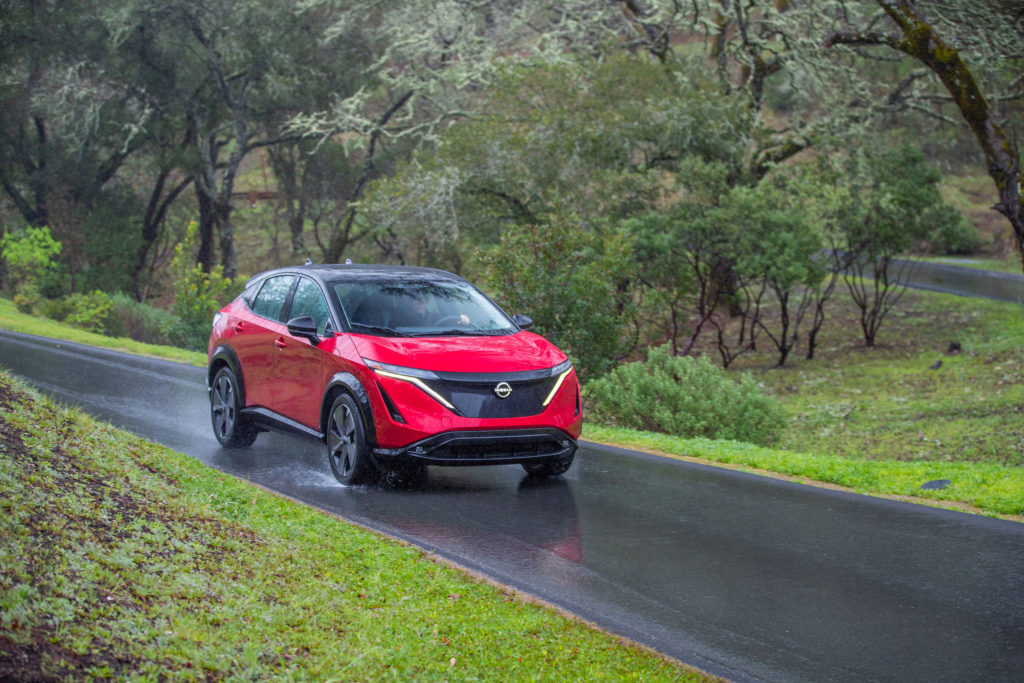
Dynamically, this SUV’s steering is quite spectacular. The ratio is quick but not nervous, the weighting is husky enough to be interesting and — get this — there’s even a bit of road feel coming up from the front tires; you actually get a sense of how much grip there is and what the road texture is like. This is almost unheard of in modern vehicles with electrically assisted steering, yet Nissan engineers have delivered.
The Ariya’s ride quality is excellent as well. Smooth yet well-controlled, the vehicle brushes off bumps without transmitting much, if any, harshness to the cabin. The body does teeter-totter the tiniest bit over surface undulations, but this ever-so-slight end-to-end bouncing is far less noticeable than in other EVs, like lower-end versions of the Mustang Mach-E.
If there’s a dynamic disappointment to this vehicle it’s undoubtedly the brakes. The pedal feels rubbery and imprecise with an awkward transition from regenerative to friction braking. Additional tuning work could be done here.
Go hands-free with ProPilot Assist 2.0
As for driver aids, the Ariya is available with ProPilot Assist 2.0, an eyes-on, hands-free highway helper cut from the same cloth as GM’s Super Cruise or Ford’s Blue Cruise. And just like those competing systems, this one operates on thousands and thousands of miles of limited-access divided roadways. At least on well-maintained sections of California highway, ProPilot Assist 2.0 works extremely well, keeping the Ariya locked in the center of its lane with minimal wandering in turns. Nissan’s visual cues are also appreciated. When the graphics in the instrument cluster are white, you can use conventional adaptive cruise control, when they turn green, adaptive cruise control with lane centering is available, and finally, when things go blue, that’s when you know you’re in a hands-free zone. Overall, this setup seems to work a touch better than Blue Cruise, but it’s hard to say if this system is also a step above GM’s segment-defining Super Cruise.
SEE ALSO: 2022 Hyundai Ioniq 5 review: One of the best
Helping prevent crashes, Nissan Safety Shield 360 is standard equipment in the Ariya. This includes six advanced driver aids: automatic emergency braking with pedestrian detection, blind spot monitoring, rear cross-traffic alert, lane-departure warning, rear automatic braking and automatic high beams.
2023 Nissan Ariya e-4ORCE checks all the right boxes
The base Ariya e-4ORCE checks out for about $48,525 including $1,335 in destination fees. Among other amenities, that outlay gets you heated front and second-row seats, a color head-up display, that nifty sliding center console and the smaller battery pack with an estimated range of 205 miles. All in, the range-topping Ariya e-4ORCE Platinum+ model evaluated here cost $62,770. That figure includes delivery, $995 for a lovely two-tone paint job and $250 for floor mats. Overall, that price seems more than fair for what you’re getting with this vehicle. Unfortunately, though, no matter the model, Nissan’s Ariya is not eligible for any federal incentives because they’re all built in Japan, so be aware of that if you’re looking to save money.
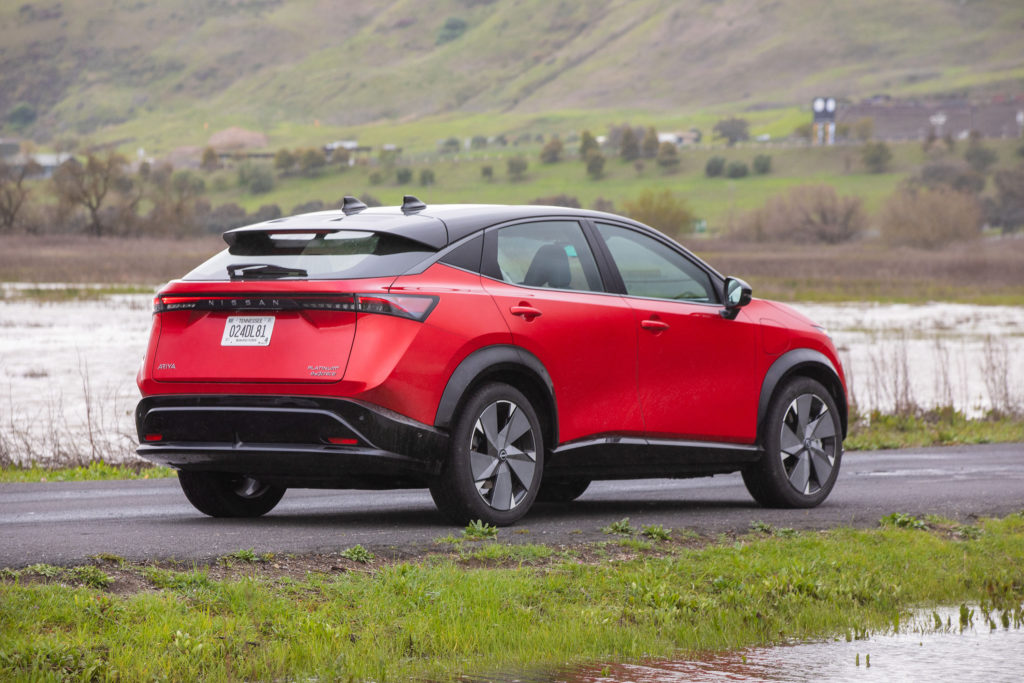
In Platinum+ e-4ORCE trim, the 2023 Nissan Ariya is one of the nicest all-electric SUVs I’ve tested. I’m super impressed by this vehicle’s clever and premium interior, quick acceleration and decent range. Sure, a few things could be improved, but really there’s little to complain about. All-wheel-drive Ariyas should start arriving at Nissan dealerships within a couple weeks, while more significant volumes are expected to show up within the next few months.
At a glance
- Year: 2023
- Make: Nissan
- Model: Ariya e-4ORCE
- Trim: Platinum+
- Type: All-electric crossover
- Horsepower: 389
- Torque: 442 pound-feet
- MPGe ratings (city/highway/combined): Not yet rated
- Estimated range: 270 miles
- Pros: Clever and upscale interior, rapid acceleration, range with all-wheel drive is pretty good, excellent ProPilot Assist 2.0 hands-free driving aid
- Cons: Lackluster advertised DC fast charging speed, poor brake pedal feel, bulbous bodywork not for everyone
- Estimated base price: $48,525 including $1,335 in destination fees
- As-tested price: $62,770 including $1,335 in destination fees
